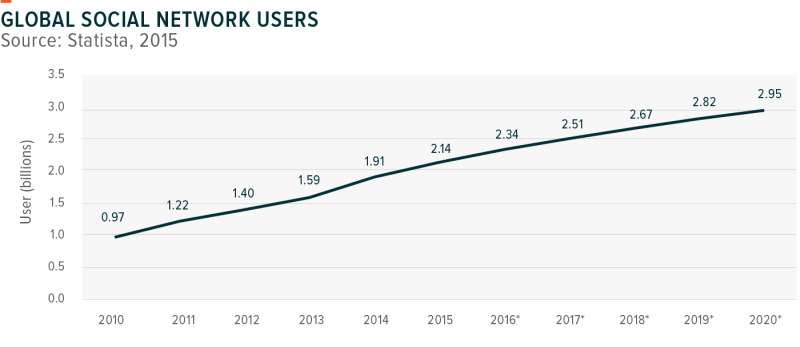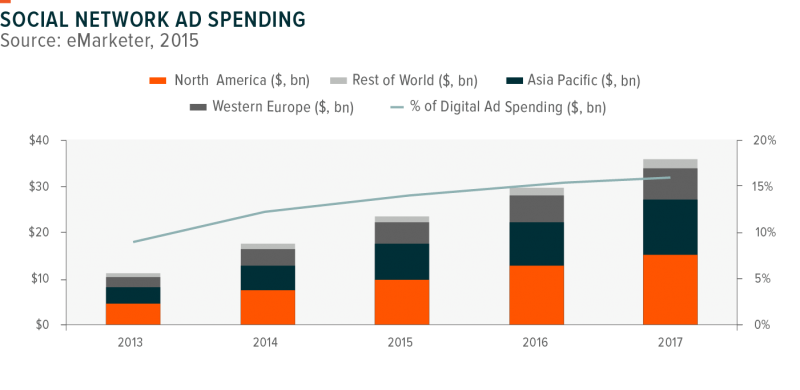Already over a decade old, the social media industry has revolutionized how the world communicates, consumes news and media, and shares ideas. Despite signs of a maturing industry – namely slowing user growth and increasing mergers and acquisitions – social media remains one of the highest growth potential areas in the Technology sector given extensive opportunities to monetize users and license data.
Social is Global
While many investors think of the major US social media names as the key players in the space, the social media industry includes many large international firms that dominate their local markets, such as China’s social media conglomerate Tencent, Japan’s LINE messaging app, and Russia’s search giant Yandex. Tencent is one of the largest internet companies in the world with nearly a billion users and a multitude of successful businesses lines including chat, digital media, and gaming.1 In some instances, these international firms have the added advantage of repeating successful US social media strategies and reaping the benefits in their local markets.
Billions of Users
Social media has enjoyed staggering growth over the last decade. Facebook, for example, had approximately one million users twelve years ago.2 Today, Facebook has more than one billion registered users and has ambitions to connect more than five billion people in the near future.3 Globally, the number of social media users has more than doubled since 2010 to over 2 billion and is expected to reach nearly 3 billion by 2020.

Naturally, user growth among the largest social media networks is slowing given the high penetration of social media among internet users. A recent study found that 74% of internet users are on social networks, making social media use nearly as common as the desktop or mobile phones.4 With such high penetration among internet users, established social media companies are looking to boost user growth by sponsoring programs that connect more people to the internet, particularly in developing nations where internet usage is less pervasive.
Monetizing the User Base
Given the billions of users already active on social media platforms, established players are no longer singularly focused on expanding their user bases, but also on monetizing their existing users; turning those users’ activity on the platform into revenue for the firm.
Monetization primarily comes from serving ads to users. Consumer-focused and commercial businesses alike are increasingly relying on social networks to build brand awareness, as well as to engage in conversations with their customers. Leveraging sophisticated ad-targeting features, businesses serve ads on social networks to specific users based on their interests, habits, and location. Marketers spent $23.7 billion on social media marketing, accounting for 13.9% of their total digital marketing spend in 2015. By 2017, global social network ad spend will reach $36 billion, growing by more than 50% and representing 16% of all digital ad spending.5

The #Millennial Effect
One of the major trends providing tailwinds to the social media industry is the rising spending power of the millennial generation. Millennials are the largest generation in the US and are expected to see their incomes quadruple over the next decade.6 However, 84% of millennials stated that they do not trust traditional advertising.7 While this could be a headwind for older media channels like print and TV, it could prove to be a boon for social media firms. Millennials are almost 3.5 times more likely to be influenced by a blog or content on a social media site than other generation.8 Therefore, to reach this highly desirable group of spenders, marketers are increasingly diverting dollars from traditional tactics to new-age social media.9
Social Media = Big Data
Social media is one of the world’s most significant sources for generating Big Data: 90% of available data in the world has been collected over the previous two years, and 80% of this data comes from “unstructured” sources like social media.10 Social media companies not only use data on clicks, shares, posts, visits, and check-ins for their own purposes of developing hyper-targeted advertising algorithms, but also they also sell this data to third parties such as advertisers and partners, data collectors, and even investors. Twitter, for example, generated nearly 13% of their Q2 2016 revenue from licensing data and other non-advertising related sales. While Twitter’s advertising revenue has grown 18% from Q2 2015 to Q2 2016, revenue from their data licensing segment has grown 34% –almost twice as fast.11 For many social media firms, their proprietary data is an extremely valuable asset that could continue to appreciate as big data and analytics continues to grow in importance to a multitude of business.
Mergers and Acquisitions
As the social media industry matures, mergers and acquisitions (M&A) activity could accelerate as firms across the Tech sector focus on maintaining growth. These deals could include older tech companies acquiring established social networking firms to integrate their user base and data, like Microsoft’s enterprise-focused acquisition of LinkedIn. It can also include larger social networks buying smaller, high-growth firms with complementary features, like Facebook’s 2014 acquisition of messaging app WhatsApp. Twitter, Snapchat, Pinterest, Yelp, Groupon, and Zynga have all been mentioned by research analysts as potential M&A targets.12
Conclusion
For more than a decade, social media has been one of the fastest growing industries in the Technology sector. While user growth is naturally slowing given high rates of social media penetration around the world, social networking firms are now focused on monetizing users through advertising and data licensing. Marketers are increasingly viewing social media as an important advertising channel given the ability to hyper-target customers, engage in direct conversations with prospects and customers, and reach millennial consumers. Given these tailwinds, we believe the social media industry is expected to continue to be one of the fastest growing segments of the Technology sector.
The Global X Social Media ETF (SOCL) offers efficient access to a broad basket of social media companies from around the world. Please click the link to access the fund’s holdings.
 Global X Research Team
Global X Research Team